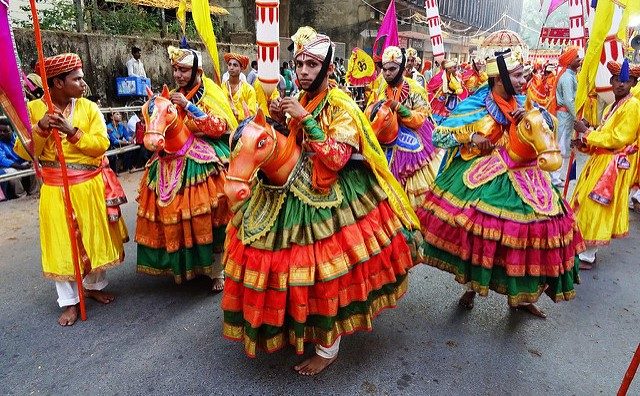Shigmo or Śigmō is a festival celebrated across Goa that marks the return of warriors to their houses after fighting the invaders. Its name is derived from the Prakrit word Suggimaho and the Sanskrit word Sugrishmaka. It may also be denoted by other names such as Shishirotsava and Shigmotsav. The festival marks the farewell to winter season.
The reason for Goa having two types of Shigmo is that the conquest of the state by the Portuguese was in two parts. First, the Portuguese had conquered what is known as ‘old conquest’, this territory constituted Tiswadi, Bardez and Salcete. Later, Portuguese expansion to the present-day territory of Goa was known as ‘New conquest’, this constituted talukas of Pernem, Bicholim, Sattari, Ponda, Quepem, Sanguem and Canacona.
The ‘Old Conquest’ suffered the most brutal period of Portuguese colonization. Many indigenous temples and mosques were destroyed and religious freedom curtailed. Under these circumstances, Hindus residing in the territory continued their age-old traditions, but under secrecy. Shigmo celebrated in the area came to be known as ‘Dhakto Shigmo’ meaning small Shigmo which is very distinct from the other version. Celebrations start Five days prior to the full-moon day of the Indian lunar month of Phalguna (the last month of the Hindu calendar) and end on the full-moon day.
The ‘New Conquest’ however was brought under the Portuguese rule as late as 19th century. By this time the colonizers had toned down their religious fervor. Hence many temples and century-old mosques survived under them in this region. ‘Vhadlo Shigmo’ meaning big Shigmo was developed in these territories. Everyone from the village participated in the festival, unlike the restrictiveness of the small Shigmo. Celebrations start on the full moon day of Phalguna, continuing for five days.
Spectacular parades are organized across the state, where men and women dressed in traditional attire perform folk dances. ‘Romta Mel’, a type of folk dance is the main highlight of the parades besides floats depicting scenes from Hindu mythology. These parades are organized in places like Panjim, Ponda etc.


